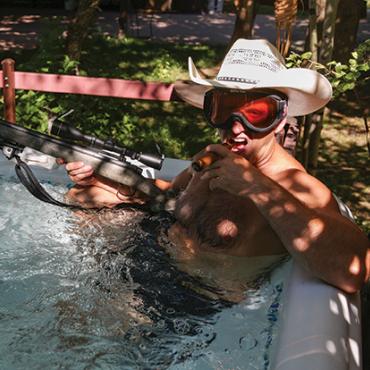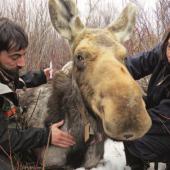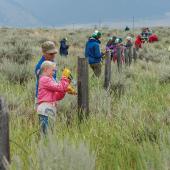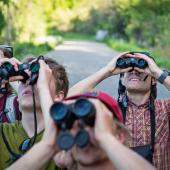Ground School
Reading the signs left behind.
Clumps of whitish-grey fur cover the ground, scattered across an oblong area a couple feet across. In some places the clusters are tinted red. The scene resembles a plane wreck on an empty hillside, viewed from high above.
“What happened here?” Ken asks.
We ponder a moment, then one by one put forth our theories. After some discussion, the consensus is an avian attack: hawk versus rabbit, the latter losing the battle, the former hauling its prize elsewhere after the fracas on the ground.
Ken remains silent. “Well?” we query. “Are we right?” We feel like underling investigators on a TV crime drama, looking to our fearless leader for affirmation.
“What are you missing?” he asks.
We look again, and suddenly realize our mistake. “That’s not fur,” one of us announces. “It’s feathers!” says another. Ken nods and smiles. Turns out it wasn’t a cottontail, but a ruffed grouse, that met its unfortunate end here on the banks of the Yellowstone on this gray spring day.
“How’d you know?” we ask Ken, incredulous. The ashen clumps are downy feathers, the soft insulation under a bird’s main plumage, and from a distance they’re indistinguishable from fur—and Ken hadn’t come within 15 feet. He points toward the brush a few yards away. There, on an old cottonwood stump, lay the grouse’s remains, wings splayed and bony feet visible. The hawk had consumed the meaty breast and left the carcass behind.
“Look around,” Ken reminds us. “There may be more to the story than what appears directly in front of you.”
And so it goes, as we wander the muddy shoreline, looking at prints left by raccoons, coyotes, geese, and deer. We’re “land-snorkeling”—slowing down, examining, inspecting, paying attention to all the minor details. In short, we’re learning to read the landscape. To see the story written on the ground before us.
We move on, through Gardiner and into the Park, stopping roadside for more impromptu lessons. I always thought I had good eyes, but Ken makes me feel like I need glasses. “There,” he says, and it takes the rest of us several minutes to find the bighorn sheep on a nearby hillside, the scratch marks on a tree, or the line of paw-prints meandering off through the forest. “Attune your eyes,” Ken says, “and a whole new world opens up.”
And he’s right. By the end of the day, strolling the sloped, snow-covered ridgelines north of Blacktail Plateau, it’s we who announce our findings. “Hey guys, over here!” Angie cries, and we all assemble to inspect the tracks of an ermine, moving from one downed tree to another. “Fox!” David later declares; we note the straight line of prints, its deliberate movement—the animal’s traveling somewhere, not hunting.
Now it’s time to work on age—was it this morning, or last night, that this elk walked through? When did that squirrel scamper across the log over there? But the answers don’t really matter. What’s important is that we know they were here. In our mind’s eye, we see these creatures moving through the very same landscape as us, living out their lives in this wild alpine forest. The big white world around us, which once seemed desolate, has grown in depth and richness. And that is more than enough.
To book your own animal-tracking or wildlife-watching trip with biologist Ken Sinay, visit yellowstonesafari.com.













